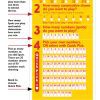Looking to up your poker game? Wondering how to calculate poker odds? You’ve come to the right place! Whether you’re a beginner or a seasoned player, understanding poker odds is crucial for making informed decisions at the table. So, let’s dive in and learn how to calculate poker odds like a pro!
When it comes to poker, having a solid grasp of odds allows you to make logical and strategic decisions. It enables you to assess the risk versus reward in any given situation. In simple terms, poker odds represent the probability of certain events occurring during a hand. By calculating these odds, you can determine whether it’s worth calling, raising, or folding.
Now, you might be wondering, “But how do I actually calculate poker odds?” Don’t worry, it’s easier than you think! To calculate poker odds, you need to know two key things: the number of “outs” you have, and the number of unseen cards in the deck. With this information, you can use a simple formula to determine your odds of winning the hand. So, let’s roll up our sleeves, grab a deck of cards, and dive into the world of poker odds calculation!
A Beginner’s Guide to Calculating Poker Odds
Calculating poker odds is essential for making informed decisions at the poker table. Here’s a step-by-step guide to help you get started:
1. Understand the basics of poker probabilities.
2. Determine your outs – the cards that will improve your hand.
3. Calculate the number of unseen cards.
4. Divide the number of outs by the number of unseen cards to get the odds.
5. Convert the odds into a percentage.
By following these steps, you’ll be able to calculate poker odds like a pro!

How Do I Calculate Poker Odds?
Welcome to our comprehensive guide on how to calculate poker odds. Whether you’re a beginner looking to improve your game or a seasoned player wanting to sharpen your skills, understanding poker odds is essential. In this article, we’ll break down the process of calculating poker odds step by step, providing you with the knowledge you need to make educated decisions at the poker table.
Why Are Poker Odds Important?
Before we dive into the intricacies of calculating poker odds, let’s first understand why they are so crucial in the game. Poker odds help you determine the probability of certain outcomes, such as making a particular hand or hitting a specific card on the turn or river. By knowing the odds, you can make informed decisions about whether to bet, call, or fold and maximize your chances of winning.
1. Understanding Outs
When calculating poker odds, the first step is to identify your “outs.” Outs are cards that can potentially improve your hand and lead to a winning outcome. For example, if you have four cards to a flush, there are nine remaining cards of that suit in the deck, making nine outs. By knowing your outs, you can calculate the probability of hitting the desired card.
Once you have determined the number of outs, you can use the “4-2 rule” or the “2-4 rule” to estimate your odds. The 4-2 rule states that if you multiply your outs by 4, you will get an approximate percentage of hitting your hand by the next card. Similarly, the 2-4 rule suggests multiplying your outs by 2 to calculate the likelihood of hitting your hand by the river.
However, it’s important to note that these rules provide rough estimates and may not be entirely accurate. For a more precise calculation, you’ll need to apply more advanced mathematical concepts, such as the “Rule of 2 and 4.”
2. The Rule of 2 and 4
The Rule of 2 and 4 is a more accurate method for calculating poker odds. It allows you to determine the probability of making your hand by the turn or river based on the number of outs you have. To apply this rule, simply multiply your outs by either 2 or 4, depending on whether you’re calculating the odds for the turn or the river.
Let’s say you have a flush draw on the flop with nine outs. By using the Rule of 2 and 4, you multiply nine by 4, resulting in a 36% chance of completing your flush by the river. Similarly, if you’re calculating the odds for the turn, you would multiply nine by 2, giving you an 18% chance of hitting your flush on the next card.
This method provides a more accurate representation of your odds, allowing you to make more informed decisions based on the likelihood of improving your hand.
3. Pot Odds and Expected Value
Another essential concept in calculating poker odds is understanding pot odds and expected value (EV). Pot odds refer to the ratio of the current pot size to the cost of a contemplated call. By comparing the pot odds to the odds of completing your hand, you can determine whether it’s profitable to make a call.
To calculate pot odds, divide the size of the pot by the cost of the call. For example, if there is $100 in the pot, and your opponent bets $20, the pot odds would be 5:1 ($100/$20). If your odds of completing your hand are better than 5:1, it would be a profitable call in the long run.
Expected value takes into account the potential gains or losses associated with a particular decision. By comparing the expected value to the cost of the call, you can assess the profitability of a play. If the expected value is positive, it indicates a favorable decision, while a negative expected value suggests it’s best to fold.
4. Using Poker Odds Calculators
While learning to calculate poker odds manually is a valuable skill, you can also take advantage of poker odds calculators to simplify the process. These tools use advanced algorithms to calculate the probabilities of making different hands and help you make more data-driven decisions.
Poker odds calculators are available as standalone software or as online tools integrated into popular poker platforms. They can provide real-time calculations based on your hand strength and the community cards, giving you a competitive edge at the table.
5. Putting It into Practice
Crafting a solid poker strategy requires more than just understanding the mechanics of calculating odds. It’s crucial to apply these concepts effectively and integrate them into your overall gameplay. Here are a few tips to help you put your newfound knowledge into practice:
- Practice Makes Perfect: Like any skill, calculating poker odds takes practice. Spend time analyzing different scenarios and calculating odds to develop your intuition.
- Consider Position: Your position at the table influences your decision-making. Take into account your position and the actions of your opponents to make more accurate calculations.
- Be Selective: Not every hand is worth pursuing. Focus on playing strong starting hands and calculating odds when you have a realistic chance of making a winning hand.
- Manage Your Bankroll: Bankroll management is crucial in poker. Even with favorable odds, if the potential loss jeopardizes your bankroll, it may not be a wise decision to make the call.
- Continuously Learn: The poker landscape is constantly evolving. Stay updated on new strategies, techniques, and tools to enhance your gameplay.
Common Mistakes to Avoid
While calculating poker odds can significantly improve your game, it’s essential to be aware of common mistakes that players tend to make:
1. Overvaluing Outs:
It’s easy to get excited about the prospect of making a winning hand and overestimate your odds. Ensure you count your outs correctly and use accurate calculations to avoid making poor decisions.
2. Neglecting Pot Odds:
Don’t overlook pot odds when making a decision. Even if you have a significant number of outs, if the pot odds aren’t favorable, it may not be profitable to continue.
3. Failing to Adapt:
Poker is a dynamic game, and the odds can change rapidly. Continuously reassess the situation and adapt your strategy accordingly to maximize your chances of success.
4. Ignoring Position:
Your position at the table is crucial in calculating poker odds. Failing to consider position can lead to poor decision-making and unnecessary losses. Take into account your position and adjust your calculations accordingly.
5. Playing Emotionally:
Emotions can cloud judgment and lead to irrational decisions. Stay calm, focused, and objective when calculating poker odds to avoid costly mistakes.
By understanding the intricacies of calculating poker odds, you can gain a significant advantage in the game. Remember to practice, consider factors like pot odds and expected value, and avoid common mistakes. With time and experience, you’ll develop a solid understanding of poker odds and make more informed decisions at the table.
Key Takeaways: How Do I Calculate Poker Odds?
- Poker odds calculation involves determining the mathematical probability of certain card combinations and outcomes in a game of poker.
- To calculate poker odds, you need to know the number of outs you have, which are the cards that can improve your hand.
- Next, you calculate the probability of getting the card you need by dividing the number of outs by the remaining cards in the deck.
- Once you have the probability, you can convert it into odds by using either a percentage or a ratio format.
- Understanding poker odds is crucial for making informed decisions and improving your overall strategy in the game.
Frequently Asked Questions
When it comes to calculating poker odds, many players find themselves unsure of where to start. Here are some commonly asked questions to help demystify the process and give you a better understanding of how to calculate poker odds.
1. What are poker odds?
Poker odds refer to the probability of certain outcomes occurring in a game of poker. They help players make more informed decisions by understanding the likelihood of different hands or events happening. By calculating poker odds, you can gauge the potential value of your hand and determine if making a particular move is advantageous.
For example, if you have four cards to a flush, knowing the odds of hitting a flush on the next card can influence your decision on whether to continue in the hand or fold.
2. How do I calculate poker odds?
Calculating poker odds involves understanding the number of “outs” you have, which are cards that can improve your hand. To calculate your odds, you divide the number of outs by the number of unseen cards. The result gives you the probability of achieving a particular hand.
For instance, if you have a flush draw after the flop with 9 outs, you can calculate your odds by dividing the number of outs (9) by the number of unseen cards (47). This will give you the probability of hitting your flush on the next card.
3. Why are poker odds important?
Poker odds are important because they can help you make more strategic decisions in the game. By knowing the odds of achieving a certain hand or making a particular move, you can better assess the risk and potential reward.
By understanding the odds, you can avoid making impulsive decisions and instead focus on making mathematically sound choices that can improve your long-term profitability in the game.
4. Can I calculate poker odds during a live game?
While it may be challenging to calculate exact poker odds during a live game, you can still use estimates and simplified calculations to get a general idea of your chances. This skill comes with practice and experience.
By observing the community cards, your opponents’ actions, and analyzing the information available, you can make educated guesses about your odds and use that information to inform your gameplay.
5. Are poker odds the same for all variations of the game?
No, poker odds can vary depending on the specific variation of the game you’re playing. Factors such as the number of community cards, the number of players, and the different hand rankings all contribute to different probabilities and odds calculations.
It’s essential to familiarize yourself with the specific rules of the variation you’re playing and adjust your calculations accordingly. Understanding the unique odds for each game will ultimately enhance your decision-making ability and increase your chances of success.
How to Calculate Pot Odds | Poker Tutorials
Summary
If you want to calculate poker odds, there are a few important things to remember. First, you need to know your outs, which are the cards that can help you make a winning hand. Then, you can use the formula (1 / [number of outs]) * 100 to find your chances of getting those cards. Remember that poker is a game of probabilities, so even if the odds aren’t in your favor, you can still win with some luck and strategy. Keep practicing and learning, and you’ll improve your poker skills over time.
In addition to calculating odds, it’s important to understand pot odds. To do this, you compare the amount of money you need to bet with the total amount that could be won. If the pot odds are higher than the odds of getting your desired card, it may be worth making the bet. However, if the pot odds are lower, it might be better to fold and wait for a better opportunity. Always consider the risks and rewards before making a decision. With practice and experience, you’ll become better at calculating poker odds and making informed choices at the table.









